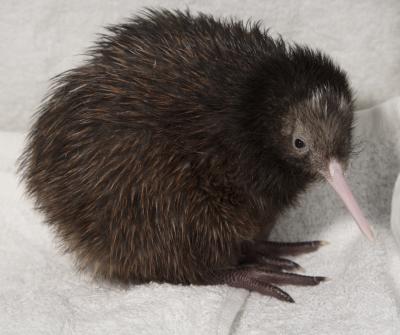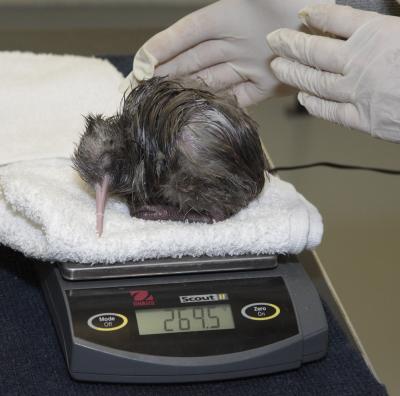tags: North Island brown kiwi, Apteryx australis mantelli, endangered species, conservation, birds, National Zoo
The National Zoo welcomed a new North Island brown kiwi chick, Apteryx australis mantelli, on March 7, 2008.
The chick, whose sex has yet to be determined by DNA testing, is the third chick to ever hatch at the National Zoo. The first hatching occurred in 1975 and was the first to occur outside of New Zealand. Kiwis are endangered and are extremely rare to see in captivity -- only four zoos outside of New Zealand have successfully bred kiwis, and only three US zoos exhibit them, including the National Zoo which has exhibited kiwis since 1967.
Image: Jessie Cohen, Smithsonian's National Zoo.
Nearly two weeks ago, a ball of fluff hatched early in the morning at the Smithsonian's National Zoo in Washington DC. But this wasn't just any ball of fluff; this is only the third individual North Island brown kiwi, Apteryx australis mantelli, to hatch at the National Zoo. This chick, if it survives, is an important addition to the population since the species is endangered, with only an estimated 24,000 individuals in the wild, a number that has dropped significantly since the 1980s, when there was an estimated 60,000 birds.
The egg had been incubated for one month by the chick's father followed by an additional five weeks incubation by zoo staff before the chick hatched. Because kiwi parents do not provide parental care after the chick has hatched, the chick is currently living in a box that has been specially designed to keep it warm while allowing it to forage.
There were two previous kiwi hatchings at the National Zoo; one in 1975, and a second in 2005. The second bird to hatch is a male named Manaia, who still resides at the National Zoo, where he is on public display three days per week.
Kiwi are ratites whose closest relatives are the Emu, which are native to Australia. There are five species of kiwi found in New Zealand, with the endangered but adaptable North Island brown kiwi being the most numerous. Kiwi are shy and nocturnal flightless birds whose numbers have been decimated by introduced rats, cats, stoats (weasels), and pigs. The birds feed on a variety of invertebrates and seeds, and are thought to consume a variety of other animals as well. Kiwi are the only birds with nostrils on the end of their long beaks, and they rely on their unusually keen sense of smell to find their meals. Kiwi mate for life, with both sexes incubating the egg. Female kiwi are remarkable for producing the largest avian egg in the world for their body size: even though an adult female brown kiwi is approximately the size of a domestic chicken, she produces an egg that is six times larger than a chicken egg!
The sex of this newly hatched chick is not yet known but will be determined using PCR technology where special regions of the bird's DNA are amplified for testing. The DNA was obtained from tissues that line the inside of the egg shell, and from a second tissue sample collected from the chick's mouth.
There will be a kiwi chick webcam available starting 14 March, so the public can watch this chick on the internet.
A newly hatched kiwi is weighed at the Smithsonian's National Zoo on March 7, 2008.
Image: Jessie Cohen, Smithsonian's National Zoo
Sources
LabSpaces (quotes)
SaveTheKiwi (information)



They're also the national bird of New Zealand and feature on our one dollar coin. Also, New Zealanders call themselves "Kiwis" :-)
Some species aren't fully nocturnal--you can see some Kiwi at dusk, for example in Stewart Island, off the bottom of the South Island of New Zealand as I did while tramping (hiking) down there. One side-effect of my hearing loss is that I can't tell the direction a sound comes from. I went out at dusk to look for kiwi and while I knew one must be quite close--I could hear shuffling (they can be very noisy when feeding) I couldn't find the bird. In frustration, I sat down on a nearby log. A kiwi shot out from under the log, went about 7-8 feet, stopped, looking at me pointedly as if to say "who the hell do you think you are?" In reality their sight is very poor, so s/he probably really was trying to figure out what I was. It then carried on feeding, shuffling about poking it beak around while I watched. Fun!
According to the web page Kiwi Myths, the claim that kiwis have the largest egg-mass-to-body-mass ratio of all birds is false, and that certain small seabirds have an even larger ratio.
Kiwis are cool, but you seem to offer a disagreement about their breeding success:
Caption: the third chick to ever hatch at the National Zoo. ... only four zoos outside of New Zealand have successfully bred kiwis
Article: this is only the fourth individual ... to hatch outside of its native New Zealand, and the third to hatch at the National Zoo.
That seems to leave at least two zoos which have apparently "bred" kiwis... without hatching them>
sorry for the confusion, david. i think i've fixed everything now.
So is this kiwi a postkiwi?